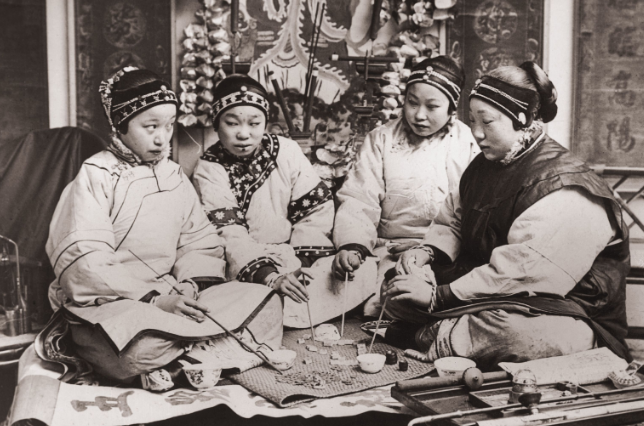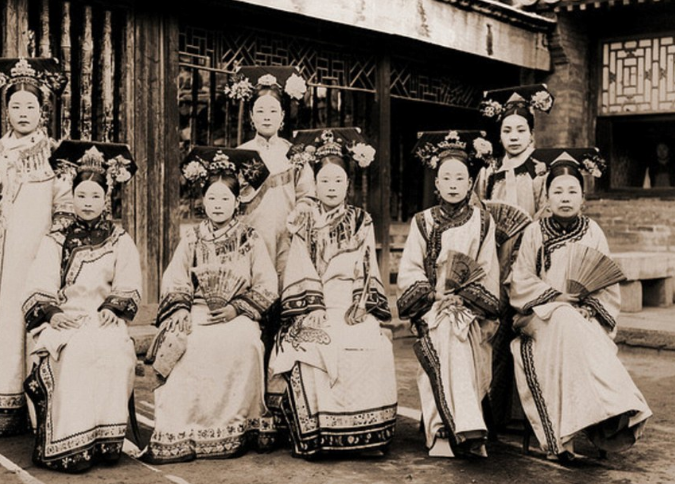Foot binding shaped Qing Dynasty Hanfu styles, influencing designs for elegance and mobility.
Historical Context of Foot Binding in Qing Dynasty
Emergence and Prevalence of Foot Binding in Qing Era
In the rich tapestry of China’s cultural history, the Qing Dynasty stands out for its continuation and endorsement of the practice of foot binding. This custom, originating in the Song Dynasty, reached new heights of popularity during the Qing era. Traditionally, families subjected their young girls, usually between four to nine years old, to this practice, believing that younger feet would mold more easily into the desired shape.
The process involved breaking the foot’s arch and tightly binding the toes underneath the sole, creating a small and arched foot, often referred to as “lotus foot.” Despite causing severe pain and lifelong disabilities, society viewed these tiny feet as symbols of beauty and elegance, essential for securing a good marriage. This practice not only represented a fashion statement but also a deep-seated cultural norm reflecting the era’s patriarchal values.
During the Qing Dynasty, foot binding transcended its origins as an elite custom to become a widespread practice across various social classes. Historical records suggest that nearly half of all Chinese women, and a majority in the upper classes, had bound feet. This staggering number highlights the depth of this tradition’s influence on Chinese society.

Sociocultural Significance of Foot Binding
Foot binding in the Qing Dynasty was a potent symbol of femininity, beauty, and social status. Women with bound feet were often perceived as more desirable and refined. This ideal was not solely imposed by men but was also embraced by women, who saw foot binding as an integral part of their identity and social value.
This practice also served as a social differentiator, especially among the Han Chinese. It acted as a marker of ethnic identity, contrasting the ruling Manchu people who typically did not practice foot binding. The distinction reinforced ethnic boundaries within the diverse empire, making it a symbol of Han Chinese cultural identity.
Foot binding carried religious and mythological significance, often linked to tales of devotion and endurance. These stories glorified women’s suffering and resilience, further embedding the practice in the cultural and spiritual domain.
It is crucial to recognize the immense physical and psychological impact of foot binding on women, causing lifelong disabilities and chronic pain. Yet, its persistence for centuries underlines its profound cultural and social significance in Qing Dynasty China.
This deep-rooted tradition of foot binding significantly influenced the fashion and clothing of the era, particularly the styles of Hanfu, reflecting the societal values and norms of the time. The impact of this practice extended far beyond mere aesthetics, offering a window into the social and cultural fabric of Qing Dynasty China.
Impact of Foot Binding on Hanfu Design Elements
Alterations in Hanfu Skirt and Sleeve Designs
The profound influence of foot binding on Hanfu, the traditional dress of the Han Chinese, is most evident in the evolution of skirt and sleeve designs. Designers of Hanfu, keenly aware of the aesthetic and mobility constraints imposed by foot binding, innovatively modified the clothing to accommodate and even accentuate this feature. This led to longer, flowing skirts that helped conceal the women’s restricted movement while adding an element of grace and elegance to their appearance.
Skirt lengths in Hanfu saw a dramatic increase, with some extending to such lengths that they would trail behind the wearer. This design not only compensated for the small, slow steps enforced by foot binding but also added a regal and ethereal quality to the wearer’s presence. The increased fabric in these skirts, often adorned with intricate embroidery and patterns, reflected the wearer’s social status and wealth. The styles and materials used in Hanfu, such as silk and brocade, further emphasized this distinction.
Sleeve designs also underwent significant changes. Designers extended the sleeves, often making them so long that they would gracefully drape to the ground. This extension of the sleeves served a dual purpose: first, it matched the elongated silhouette created by the longer skirts, and second, it provided a counterbalance to the restricted mobility of the feet, allowing for more expressive movements of the arms and hands.
Adaptations in Footwear Styles for Bound Feet
Foot binding significantly influenced the development of footwear styles during the Qing Dynasty. Cobblers and designers tailored shoes specifically for bound feet, creating a distinct category of footwear that was both functional and symbolic. These shoes, often referred to as “lotus shoes,” were small, delicately made, and richly decorated, mirroring the prestige and aesthetic appeal of bound feet.
Lotus shoes typically featured elevated soles to give the illusion of height, compensating for the reduced stature due to foot binding. The height of these soles varied, but on average, they were about 2 to 3 inches high. The materials used for these shoes were often luxurious, with silk, satin, and cotton being the most popular choices. Embroidery on lotus shoes was an art form in itself, with patterns often symbolizing good luck, wealth, and happiness.
The practical aspect of these shoes was as crucial as their aesthetic appeal. Despite their small size, they needed to provide stability and support to the wearer. The craftsmanship involved in making these shoes was highly skilled, ensuring that they were sturdy enough to be used in daily life while still being a symbol of beauty and refinement.
The practice of foot binding in Qing Dynasty China had a profound impact on Hanfu designs, leading to significant alterations in both clothing and footwear. These changes were not just functional adaptations but also reflected the cultural and social significance of foot binding in the society of that time. The elongated skirts and sleeves of Hanfu, along with the distinctive lotus shoes, stand as testament to the way historical practices and beliefs can shape fashion and aesthetics.
Functional Adjustments in Hanfu due to Foot Binding
Modifications in Clothing for Mobility Constraints
The custom of foot binding significantly influenced Hanfu design, leading to essential modifications that catered to women’s mobility constraints. Designers creatively adapted Hanfu to accommodate the limited movement caused by bound feet, integrating wider, more flowing skirts into the design. This change allowed women to move more freely, despite the shuffling steps enforced by their bound feet.
In an innovative response to these mobility challenges, designers incorporated flexible and adjustable waistbands in Hanfu garments. These waistbands ensured a comfortable fit while facilitating easier movement. Designers also chose lighter and more breathable fabrics to reduce the garments’ weight, thus lessening the physical burden on the wearer.
To enhance mobility further, designers introduced strategic side slits in the skirts of Hanfu. These slits allowed for greater leg movement, a crucial adaptation given the restricted stride of women with bound feet. Designers skillfully combined functionality with aesthetics, often embellishing these slits with intricate embroidery or using contrasting fabrics as linings, adding elegance to the practical design.
Ergonomic Design Changes in Hanfu for Comfort
Alongside mobility-focused modifications, Hanfu designs also evolved to prioritize ergonomic comfort for women with bound feet. Designers paid meticulous attention to the fit and cut of the garments, ensuring that they were comfortable and visually appealing. Relaxed fits became a preferred choice, eliminating any tight or constrictive elements that could add discomfort.
Designers also rethought the traditional layering in Hanfu, aiming to minimize bulkiness, especially around the lower body. This approach led to a preference for thinner, more flexible layers, which offered warmth and coverage without the added weight and bulk.
The necklines and collars of Hanfu garments underwent a transformation, becoming looser and less restrictive. This adjustment not only enhanced comfort but also balanced the garment’s visual proportions, complementing the elongated silhouette created by the longer skirts and sleeves.
These innovations in Hanfu design demonstrate a thoughtful response to the cultural practice of foot binding. They highlight the adaptability and ingenuity of traditional Chinese fashion, evolving to meet the needs of its wearers while maintaining elegance and style. The evolution of Hanfu during the Qing Dynasty is a testament to the dynamic interplay between cultural practices and fashion trends.

Foot Binding Influence on Aesthetics and Symbolism in Hanfu
The Aesthetic Integration of Small Feet in Hanfu
The aesthetic allure of small feet in Qing Dynasty China profoundly influenced the styling and presentation of Hanfu. Designers strategically crafted these garments to emphasize the delicacy and smallness of bound feet, a feature highly prized in this era. The elongated skirts and flowing sleeves of Hanfu were not mere fashion statements but deliberate choices to draw attention to the tiny, ‘lotus-like’ feet. This aesthetic choice resonated deeply with the contemporary ideals of beauty, where smaller feet were synonymous with elegance and refinement.
Hanfu designers also played with color contrasts and fabric textures to accentuate the smallness of the feet. Darker shades and heavier fabrics were often used for the lower part of the garment, drawing the eye downwards towards the feet, which were usually clad in intricately embroidered shoes. This contrast created a visual emphasis on the small size of the feet, further enhancing their perceived beauty.
The very structure of Hanfu adapted to this aesthetic preference. Longer hemlines reduced the visibility of the feet, making them appear even smaller and more delicate. This design choice was a deliberate effort to align Hanfu with the prevailing beauty standards that equated small feet with desirability and femininity.
Symbolic Representation of Bound Feet in Clothing Patterns
Bound feet in Qing Dynasty China were not just a physical attribute but carried rich symbolic meanings, which Hanfu designers skillfully incorporated into clothing patterns. These patterns often contained motifs and symbols that referenced the cultural and spiritual significance of foot binding. For example, the lotus flower, a recurring theme in Chinese art and literature, was commonly used in Hanfu patterns to symbolize bound feet. This symbolism drew a parallel between the beauty and delicacy of the lotus and the similarly perceived qualities of small, bound feet.
Designers also used imagery and patterns that conveyed stories and legends associated with foot binding. These narratives, often romanticized tales of love and sacrifice, were woven into the fabric of Hanfu, making the garments not just items of clothing but carriers of cultural stories and values.
The use of auspicious symbols and motifs in Hanfu patterns was a common practice. These symbols, believed to bring good luck and prosperity, were intricately linked with the practice of foot binding, reinforcing the belief that bound feet were not only beautiful but also auspicious.
In summary, the influence of foot binding on the aesthetics and symbolism of Hanfu during the Qing Dynasty was profound. Designers not only adapted the physical aspects of the garments to accommodate and emphasize small feet but also imbued them with rich cultural and symbolic meanings. This integration of aesthetics and symbolism in Hanfu highlights the deep connection between fashion, cultural practices, and societal values in historical China.